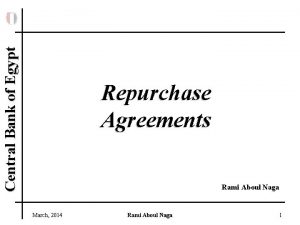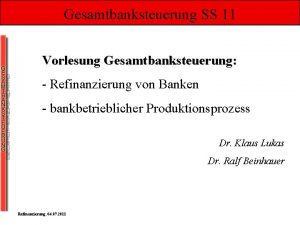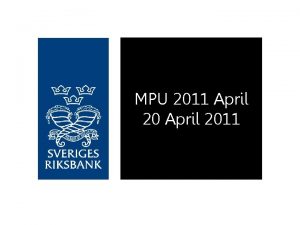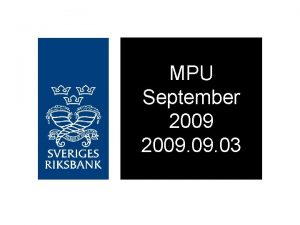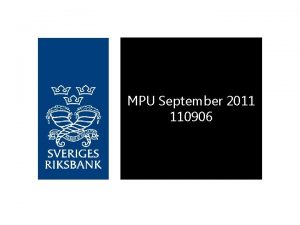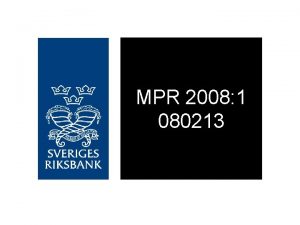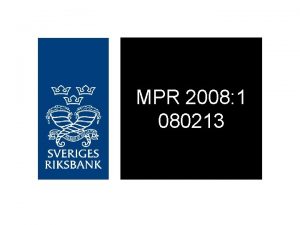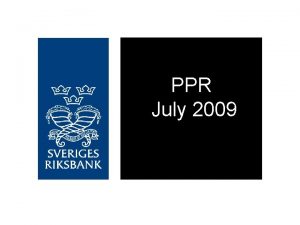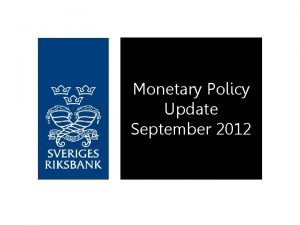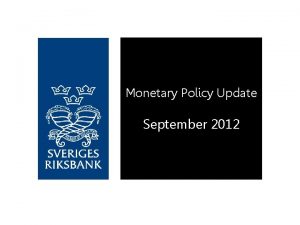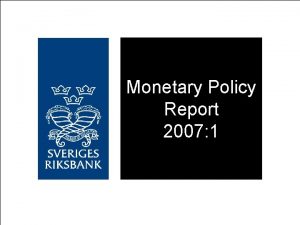MPU 2010 3 101215 Figure 01 Repo rate






















- Slides: 22

MPU 2010: 3 101215

Figure 01. Repo rate with uncertainty bands Per cent, quarterly averages Note. The uncertainty bands for the repo rate are based on the ability of risk-adjusted market rates to forecast the future repo rate. This uncertainty band does not take into account the fact that there may be a lower bound for the repo rate. Source: The Riksbank

Figure 02. GDP with uncertainty bands Annual percentage change, seasonally-adjusted data Note. The uncertainty band shows the band within which GDP growth is expected to be with a 50%, 75% and 90% probability. There is also uncertainty for the outcomes for GDP, as the National Accounts figures are revised several years after the preliminary publication. Sources: Statistics Sweden and the Riksbank

Figure 03. CPI with uncertainty bands Annual percentage change Note. The uncertainty band shows the band within which inflation is expected to be with a 50%, 75% and 90% probability. Sources: Statistics Sweden and the Riksbank

Figure 04. CPIF with uncertainty bands Annual percentage change Note. The uncertainty band shows the band within which inflation is expected to be with a 50%, 75% and 90% probability. The uncertainty regarding the CPIF forecast is based on the Riksbank's forecast errors for the CPIX during the period 1999 until the introduction of published CPIF forecasts in 2008, with an adjustment for the fact that the CPIF and the CPIX have varied to different degrees. Sources: Statistics Sweden and the Riksbank

Figure 05. GDP Quarterly changes in per cent, annual rate, seasonally-adjusted data Sources: Statistics Sweden and the Riksbank

Figure 06. Unemployment Percentage of the labour force, seasonally-adjusted data Note. Pre-1993 data has been spliced by the Riksbank. Broken lines represent the Riksbank’s forecast, 15 -74 years. Sources: Statistics Sweden and the Riksbank

Figure 07. Labour force and number of employed Thousands, seasonally-adjusted data Note. Pre-1993 data has been spliced by the Riksbank. Broken lines represent the Riksbank’s forecast, 15 -74 year. Sources: Statistics Sweden and the Riksbank

Figure 08. CPI, CPIF and CPIF excluding energy Annual percentage change Note. CPIF is CPI with a fixed mortgage interest rate. Sources: Statistics Sweden and the Riksbank

Figure 09. Real repo rate Per cent, quarterly averages Note. The real repo rate is calculated as an average of the Riksbank’s repo rate forecasts for the coming year minus the inflation forecast (CPIF) for the corresponding period. Source: The Riksbank

Figure 10. TCW-weighted exchange rate Index, 18. 11. 92 = 100 Note. Outcome data are daily rates and forecasts are quarterly averages. Source: The Riksbank

Figure 11. Oil price, Brent crude USD per barrel Note. Futures are calculated as a 15 -day average. Outcomes represent monthly averages of spot prices. Sources: Intercontinental Exchange and the Riksbank

Figure 12. Development of GDP in different regions and countries Quarterly changes in per cent, annual rate, seasonally adjusted data Sources: Bureau of Economic Analysis, Eurostat, Statistics Sweden and the Riksbank

Figure 13. GDP-gap and RU-indicator Percentage deviation from potential level and standard deviation Note. GDP-gap (HP) refers to the deviation from trend in GDP calculated with a Hodric Prescott filter. The GDP gap (PF) refers to the deviation from trend in GDP calculated with a production funtion. The RU-indicator is normalized so that the mean value is zero and the standard deviation is 1. Sources: Statisitcs Sweden and the Riksbank

Figure 14. Hours gap Percentage deviation from potential level Note. The hours gap (HP) refers to the deviation from trend in the number of hours worked calculated with a Hodrick Prescott-filter. The hours gap refers to the deviation in the number of hours worked from the Riksbank's assumed trend for the numbers of hours worked. Sources: Statistics Sweden and the Riksbank

Table A 1. Repo rate forecast Per cent, quarterly average values Repo rate 2010 Q 3 0. 55 2010 Q 4 1. 0 (1. 0) 2011 Q 1 1. 4 (1. 3 ) 2011 Q 4 2. 0 (2. 0) 2012 Q 4 2. 9 (2. 9) 2013 Q 4 3. 4 (3. 4) Source: The Riksbank

Table A 2. Inflation, annual average Annual percentage change Note. CPIF is CPI with fixed interest rate. HICP is an EU harmonised index of consumer prices which does not include household mortgage costs. Sources: Statistics Sweden and the Riksbank

Table A 3. Summary of financial forecasts Annual average, per cent, unless otherwise specified * Per cent of GDP Sources: Statistics Sweden and the Riksbank

Table A 4. International conditions Annual percentage change Note. The figures in parentheses indicate the global purchasing-power adjusted GDP-weights, according to the IMF. The Swedish export market index is calculated as a weighted average of the imports of the 15 countries which are the largest recipients of Swedish exports. They receive approximately 70 per cent of Swedish exports. Sources: Eurostat, IMF, Intercontinental Exchange, OECD and the Riksbank

Table A 5. GDP by expenditure Annual percentage change, unless otherwise specified *Contribution to GDP growth, percentage points Note. The figures show actual growth rates that have not been calendar-adjusted, unless otherwise stated. NA is the National Accounts. Sources: Statistics Sweden and the Riksbank

Table A 6. Production and employment Annual percentage change, unless otherwise stated * Per cent of labour force Note. Potential hours refers to the long-term sustainable level for the number of hours worked. Sources: Statistics Sweden and the Riksbank

Table A 7. Wages and unit labour cost for the economy as a whole Annual percentage change, calendar-adjusted data * Contribution to the increase in labour costs, percentage points. Note. NMO is the National Mediation Office’s short-term wage statistics and NA is the National Accounts. Labour cost per hour is defined as the sum of actual wages, collective charges and wage taxes divided by the seasonally adjusted total number of hours worked. Unit labour cost is defined as labour cost divided by seasonally adjusted value added at constant prices. Sources: National Mediation Office, Statistics Sweden and the Riksbank
 Repo rate formula
Repo rate formula Repo rate definition
Repo rate definition Rami aboul naga
Rami aboul naga Private suse repository
Private suse repository Multiplicator monetar
Multiplicator monetar 50 repo
50 repo Repo
Repo Callie wall
Callie wall Gesamtbanksteuerung vorlesung
Gesamtbanksteuerung vorlesung Mpu rotterdam
Mpu rotterdam Mpu tersusun dari tiga bagian pokok yaitu
Mpu tersusun dari tiga bagian pokok yaitu Sumerian and indus valley civilization
Sumerian and indus valley civilization Mpu subject是什么
Mpu subject是什么 Itrs roadmap
Itrs roadmap Mpu architecture
Mpu architecture Mpu 2312
Mpu 2312 Mpu
Mpu Mpu
Mpu Bagian bagian dari mpu sebuah mikroprosesor adalah
Bagian bagian dari mpu sebuah mikroprosesor adalah Arduino utasításkészlet
Arduino utasításkészlet Mpu hr
Mpu hr Cap rate interest rate relationship
Cap rate interest rate relationship Nominal v. real interest rates
Nominal v. real interest rates


